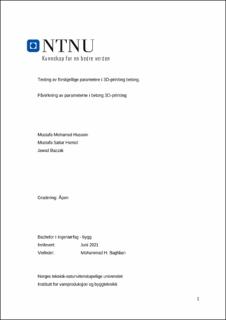| dc.contributor.advisor | Mohammad H. Baghban | |
| dc.contributor.author | Mustafa Hussein | |
| dc.contributor.author | Mustafa Sattar Hamid | |
| dc.contributor.author | Jawad Bazzak | |
| dc.date.accessioned | 2021-09-24T19:48:15Z | |
| dc.date.available | 2021-09-24T19:48:15Z | |
| dc.date.issued | 2021 | |
| dc.identifier | no.ntnu:inspera:77257390:81861961 | |
| dc.identifier.uri | https://hdl.handle.net/11250/2782321 | |
| dc.description.abstract | Det er en økende etterspørsel i dagens marked for utvikling av betong teknologien, bruk av nye innovasjoner har ført til bygging av konstruksjoner med 3D-printing betong.
Vår oppgaves problemstilling ser slik ut; Testing av forskjellige parametere på kvalitet av 3D-printing betong. For å besvare det spørsmålet har vi utført tester som kunne fortelle oss om bearbeidbarhet, holdbarhet, fasthet og styrke av betong blandingene. De testene fortalte oss, at alle de hadde sammenheng med hverandre i både flyttbarheten, styrken og dens evne for å ekstrudere.
For å analysere de resultatene hadde vi diagrammer i både 2D og 3D og vi måtte lære litt om maskinlæring også. Vi brukte Matlab for å tegne de 3D-diagrammene og vanlig Excel for å tegne de 2D-diagrammer. Etter vi gjøre alle testene våre ferdig, vi tastet inn vårt resultat data i eksisterende Python koder for å forutse om de gir like gode eller tilnærmet resultat og vi brukte lineær regresjon og neural network. Vi fikk feil forutsi i noen av de resultatene vi har fått fra lineær regresjon og neural network i noen av de testene.
Ved blanding av kalkstein, flyveaske, v/c eller matriks volum fant vi ut, oppførselen av hver enkelt parameter og hvilken av de gjøre blandingen harde eller flyttende. Det var noen få tester som ga oss gode resultater i flyttbarhet, styrke, fasthet og som kunne ekstruderes uten noe overflate feil. Miks navn SV4, med blanding mellom matriks volum og kalkstein ga de beste resultatene, da den hadde god flyttbarhet, styrke, og evnen til å ekstruderes. | |
| dc.description.abstract | There is a growing demand in today's market for the development of concrete technology, the use of new innovations has led to the construction of structures with 3D concrete printing.
The problem of our thesis looks like this; Testing of various parameters on the quality of 3D-printing concrete. To answer that question, we performed tests that could tell us about the workability, durability, firmness, and strength of the concrete mixtures. Those tests told us that all of them were related to each other in terms of flowability, strength and its ability to extrude.
To analyze those results, we had diagrams in both 2D, and 3D and we had to learn a little about machine learning as well. We used Matlab to draw the 3D diagrams and regular Excel to draw the 2D diagrams. After we finished all our tests, we entered our result data into existing Python codes to predict whether they would give us equal or approximate results and we used linear regression and neural network. We had some prediction errors from linear regression and neural network for some of the tests.
When mixing limestone, fly ash, v / c and matrix volume, we found out, the behavior of each parameter and which of them make the mixture hard or moving. There were a few tests that gave us good results in mobility, strength, firmness and that could be extruded without any surface defects. Mix name SV4, with a mixture of matrix volume and limestone gave the best results, as it had good portability, strength, and the ability to be extruded. | |
| dc.language | nob | |
| dc.publisher | NTNU | |
| dc.title | Testing av forskjellige parametere i 3D-printing betong.
Påvirkning av parameterne i betong 3D-printing. | |
| dc.type | Bachelor thesis | |
